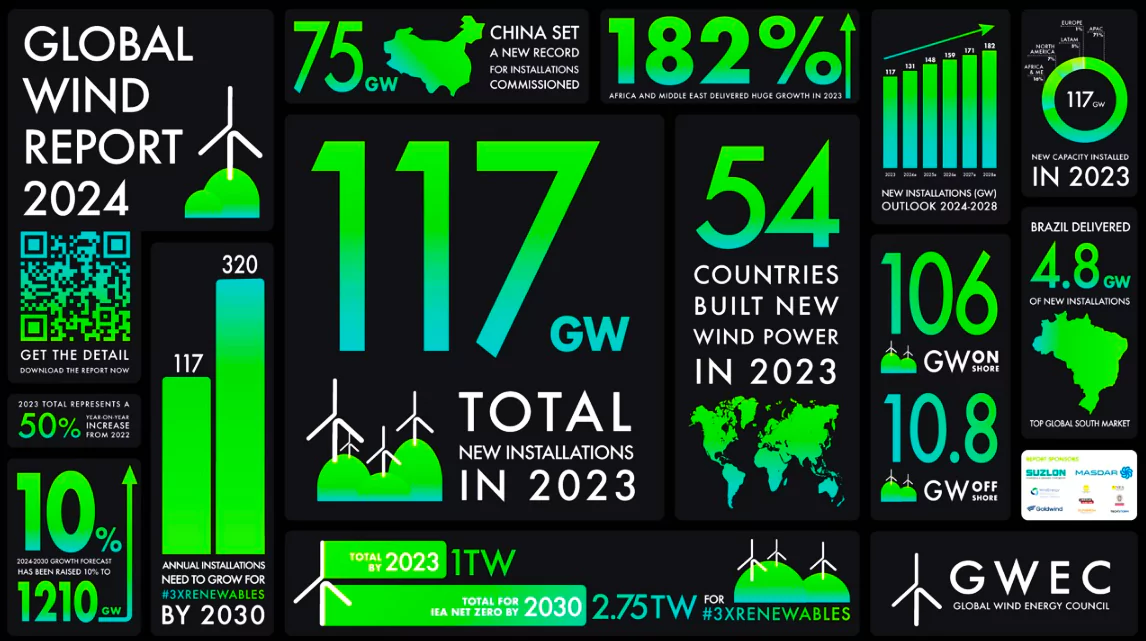Context
According to the latest Global Wind Report 2024, the world installed 117 gigawatts of new wind power capacity in 2023, a 50% increase from the year before.
Key Highlights of Global Wind Report 2024
- Year-on-Year Expansion: Observed across 54 countries on all continents.
- Global Installed Onshore Wind Capacity: Surpassed 100GW mark for the first time, growing by 54% year-on-year.
- Global Offshore Wind Installations: Reached 10.8GW in 2023.
- Cumulative Global Wind Power Capacity: Exceeded 1-terawatt (TW) milestone, reaching 1021GW, with a 13% year-on-year increase.
 Yearly Growth Rate: Needs to triple to install 320GW of new capacity yearly by 2030 to achieve net-zero emissions by 2050.
Yearly Growth Rate: Needs to triple to install 320GW of new capacity yearly by 2030 to achieve net-zero emissions by 2050.- Regional Progress on Wind Energy:
- China: Installed record 75GW of new installations.
- Top Markets: US, Brazil, Germany, India.
- Asia-Pacific: 106% year-on-year increase, led by China.
- Latin America: 21% increase, led by Brazil.
- Africa and Middle East: Surged by 182%.
Enroll now for UPSC Online Course
Challenges in the Wind Energy Sector
- Supply Chain Constraints: Global supply chain disruptions have impacted the availability and cost of wind turbine components, especially from dominant producers like China.
- Permitting and Regulatory Hurdles: Slow and complex permitting processes delay project deployments, significantly hindering growth in the wind sector.
India’s Wind Energy Potential
- India globally ranks fourth after China, the US and Germany, in terms of installed wind energy capacity, with 42.8 GW (onshore wind) as of April 2023.
- Assessment by the National Institute of Wind Energy reveals an estimated wind power potential of 695.5 GW at 120 meters and 1,164 GW at 150 meters above ground level.
|
- Technological Limitations: Existing wind turbine technologies face limitations in efficiency, especially in lower wind speed regions.
- Market and Financial Challenges: The wind sector often experiences financial instability due to fluctuating policy support, market volatility, and competitive pricing pressures.
- Environmental and Social Impact Concerns: Wind projects can face opposition due to their environmental impact on wildlife and the local community concerns about noise and aesthetic disruption.
- Interconnection and Grid Integration Issues: Integrating large-scale wind power into the existing grid poses technical challenges due to the variability and location-specific nature of wind energy.
Way Forward to the Wind Energy Sector
- Integrated Approach: The report advocates for a comprehensive strategy involving public/private partnerships to drive substantial investment into wind energy.
- Policy and Market Development: It emphasizes the need for stable and attractive policy environments that ensure reasonable investment returns and recognize the socioeconomic benefits of wind energy.
- Global Supply Chain Security: The report suggests building a robust supply chain with managed competition and advises against protectionist trade policies that could increase costs for consumers.
- Technological and Production Innovations: The report calls for industry collaboration in technical development and standardization to streamline production and ensure environmental, social, and governance (ESG) compliance.
- AI and Machine Learning: It recommends harnessing AI for supply chain and siting optimization while managing workforce transition and cybersecurity risks.
- Grid Infrastructure Development: The report stresses making grid development a cross-cutting policy priority, with emphasis on investment in grid flexibility and cross-border integration.
- Equitable Industry Transition: The report emphasizes on achieving socioeconomic cohesion and inclusivity within the wind industry, promoting pathways for workers transitioning from high-carbon sectors.
Also Read: Clean Energy Share In India And Its States’ Electricity Mix
![]() 17 Apr 2024
17 Apr 2024
 Yearly Growth Rate: Needs to triple to install 320GW of new capacity yearly by 2030 to achieve net-zero emissions by 2050.
Yearly Growth Rate: Needs to triple to install 320GW of new capacity yearly by 2030 to achieve net-zero emissions by 2050.